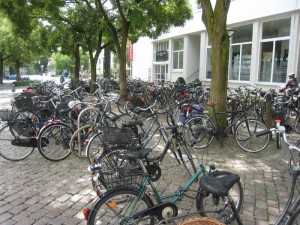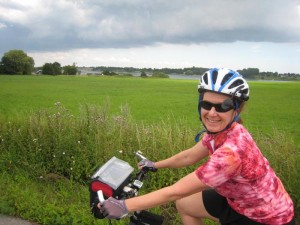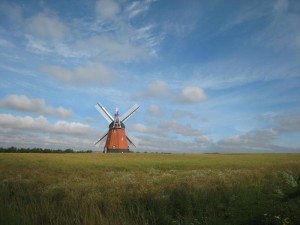Editor’s note: While interviewing Steve Wilson, a long time Tucson cyclist and former GABA President, for last week’s rider of the week, I learned he spent part of the summer biking overseas. I asked him if he wanted to submit an article for the summer sightseeing series. Here is his post:
 So we’ve all heard about how great the cycling is in the Netherlands and Denmark, and northern Europe in general. Is it true, we wondered, as we headed over for a four week vacation with three weeks of unsupported touring and a week of family wedding activities? We can safely say the answer is a resounding yes!
So we’ve all heard about how great the cycling is in the Netherlands and Denmark, and northern Europe in general. Is it true, we wondered, as we headed over for a four week vacation with three weeks of unsupported touring and a week of family wedding activities? We can safely say the answer is a resounding yes!
Our touring ideas were hatched when Patricia found out her nephew was getting married in Copenhagen this summer (2011). We’re big fans of combining family visits around the world with some great touring adventures, and this was no exception. We grabbed some maps and roughed out a plan that would take us from Copenhagen to Amsterdam before the wedding, and from Copenhagen to southern Norway after. We filled in some of the blanks with the correct train trips for returns so we didn’t miss anything important (like the wedding or our return flight).
 As soon as you step out of the airport and head in to Copenhagen you know you are in a different world. The sheer number of cyclists is overwhelming. I can’t say it’s all better than Tucson, but the overall accommodation for cyclists is impressive. There are fundamental differences from Tucson, namely almost everywhere there are three areas of travel, one for cars, one for bikes, and one for pedestrians. Instead of a separate path well off the roadway, in most places it is immediately adjacent to the road with a small curb separator. The intersections have separate lights just for the bikes, so again there are three sets of signals.
As soon as you step out of the airport and head in to Copenhagen you know you are in a different world. The sheer number of cyclists is overwhelming. I can’t say it’s all better than Tucson, but the overall accommodation for cyclists is impressive. There are fundamental differences from Tucson, namely almost everywhere there are three areas of travel, one for cars, one for bikes, and one for pedestrians. Instead of a separate path well off the roadway, in most places it is immediately adjacent to the road with a small curb separator. The intersections have separate lights just for the bikes, so again there are three sets of signals.
The level of courtesy and respect is probably the most shocking. I’m sure there are aggressive drivers there, we just didn’t see any. And it helps that they are all driving smaller vehicles than F-150s. Drivers would routinely edge out of a driveway to see if the way was clear, and upon seeing a bike they would back up. After seeing this about 20 times I figured out that’s just what they do.
 Bike parking is sometimes a challenge, but there are bike racks everywhere and the city isn’t cursed with the same level of aggressive bike thieves that Tucson has. We left our Surlys locked together on the street at night more than once. Just not a problem to the degree it is here. The bike parking at the Amsterdam train station holds 7,000 bicycles. You have to see it to believe it, and it’s not big enough.
Bike parking is sometimes a challenge, but there are bike racks everywhere and the city isn’t cursed with the same level of aggressive bike thieves that Tucson has. We left our Surlys locked together on the street at night more than once. Just not a problem to the degree it is here. The bike parking at the Amsterdam train station holds 7,000 bicycles. You have to see it to believe it, and it’s not big enough.
Heading cross country was a wonderful experience. The Netherlands and Denmark have fabulous bike routes through the countryside, and it’s not bad in northern Germany either. Being flatter and having lots of country roads gives them many options we don’t have here. The system in the Netherlands was particularly easy to follow. Heading in to Amsterdam we were still in rural countryside until we were 2 miles from the city center. Not quite like biking in to LA or Phoenix.
Interestingly I would say we have as many recreational cyclists in Tucson as any place over there, maybe more. There, 95 percent of the cycling is utilitarian or touring. The recreational cyclists there do actually wear helmets (at least 75 percent), but among all of the other riders the rate is more like 5 percent.
 Because of some weather (wind and rain) and needing to get back to Copenhagen we had a chance to utilize the trains quite a bit. For the most part it all worked really well. Generally you just wheel your bike into the car with the bicycle emblem on it and park it in the designated area. Sometimes you pay extra for the bike, sometimes you don’t. It generally wasn’t hard to figure out. For the long trips back to Copenhagen we had some fears about the number and timing of transfers but it all worked out.
Because of some weather (wind and rain) and needing to get back to Copenhagen we had a chance to utilize the trains quite a bit. For the most part it all worked really well. Generally you just wheel your bike into the car with the bicycle emblem on it and park it in the designated area. Sometimes you pay extra for the bike, sometimes you don’t. It generally wasn’t hard to figure out. For the long trips back to Copenhagen we had some fears about the number and timing of transfers but it all worked out.
The biggest downside is the weak US dollar. It is pricey there, but with some bargain hunting you can make things reasonable. Most bigger places have hostels and nice grocery stores. The beer was uniformly good.

Thanks for the article. It is interesting to see how other places are. One thing you didn’t mention is WHY so many people ride bikes there. Hint, most people didn’t start riding there because they were in love w/ cycling or they had altruistic motives. I’m not saying our way is better than theirs, I’m just asking for full disclosure so folks here will understand the full situation over there.
3wheeler – it’s a complex situation for sure. One of the fundamental differences in Denmark is that there isn’t a huge auto and petroleum industry that tries to kill any attempt to spend transportation money on anything but roads for cars (like we have here). Once the facilities are in place people find that it is often easier, faster, and more fun to ride a bike than drive a car, especially in cities. Just look at the current mood in Congress, they want to cut all funds for cycling facilities, but not for roads for cars and trucks. $8 a gallon for gas certainly helps the situation there as well 🙂
Steve
Steve, thanks for the reply, but I was hoping you would give a more factual answer that accurately reflects the situation. I can’t believe you think car companies are afraid that bicycles will take away their profits and that they are involved in an anti bike conspiracy. (Don’t bring up the 1930’s streetcar scandal, I know about it and know that there is no correlation.)
Denmark has a high number of cyclists because they tax gasoline and cars themselves like you wouldn’t believe. I am very pro bike, but I would do everything in my power to keep that from happening here. Cycling has many advantages, and when given a reasonably even field, the number of cyclists will increase dramatically. However, cars are so much more convenient and comfortable for many tasks that it is foolish to think that any place could achieve such high numbers of cyclists without penalizing car operation. If the taxes on gas and cars were lifted in Denmark today, and the cycling infrastructure were retained, the folks there would go back to driving cars at a percentage rate that would be far more than it is now, but less than it was in the ’70’s.
3wheeler – so why do you think so many Congressmen are so aggressively going after the 2% TE funding in the transportation bill? You don’t think there is any lobbying going on there? It’s not a conspiracy, it’s just financial self interest, and almost no one is lobbying the other side
As you state, increasing the number of cyclists dramatically will have an impact on car operation. I say that sounds fair to me – car operation has been negatively impacting bike operation for our whole lives.
Americans basically worship the automobile. I’m hoping the price of gas keeps going up. The health gains for Americans would likely offset the economic impact in the long run. It was hard to find an obese person in Copenhagen, in Tucson… well not so hard.
Steve
Steve…right on. I’ve done a lot of traveling and living in Europe/England and totally agree with your perceptions.
ditto